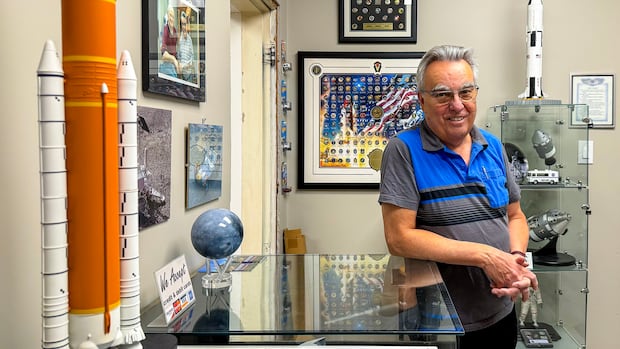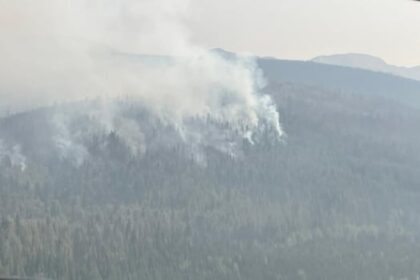British ColumbiaDowntown Dawson Creek isn’t where you might expect to take a tour of the history of the Space Race. But hidden inside an autobody shop, space historian Nick Proach has filled the city’s newest museum with dozens of scale model rockets that have appeared in museums, world fair exhibits, and even aboard NASA spacecraft. World-renowned model maker’s new Dawson Creek museum highlights half a century of handcrafted spacecraftMatt Preprost · CBC News · Posted: Nov 22, 2025 8:00 AM EST | Last Updated: 2 hours agoListen to this articleEstimated 5 minutesThe audio version of this article is generated by text-to-speech, a technology based on artificial intelligence.Nick Proach inside his space model museum in Dawson Creek, B.C. Hidden inside an autobody shop, the space historian has filled the city’s newest museum with dozens of scale model rockets that have appeared in museums, world fair exhibits, and even aboard NASA spacecraft. (Matt Preprost/CBC)At his workbench inside an autobody shop in downtown Dawson Creek, Nick Proach has just put the finishing touches on his latest creation — a scale replica of Skylab, the first U.S. space station.The model’s tiny solar arrays, command module, and telescope mount measure just 30 inches (76 centimetres), a small stand-in for the real Skylab, which measured 100 feet (30.5 metres). But it’s built to millimetre precision, just like the dozens of other miniature spaceships that fill the display cases around him.“Going around the Earth in orbit and going out to the moon … to me, that’s probably the biggest, single most exciting adventure ever,” says Proach.Nick Proach with a display case featuring the Apollo space program at his model museum in Dawson Creek, B.C. (Matt Preprost/CBC)Proach has spent more than 50 years recreating the milestones in human spaceflight and building these specialized models for big clients around the world.He grew up in Toronto during the height of the Space Race in the 1960s, glued to the TV as the first astronauts blasted off into new frontiers. By the time he was 10, he was building models out of cardboard, plastic scraps, toothpicks, and toy tires.“I saw a photo of the lunar rover that they were going to use for the first time on the moon during the Apollo 15 mission,” he recalls. “I thought, ‘Hey, this is a neat, neat little hot rod. I got to make me one of these.’”WATCH | Space museum in Dawson Creek:Dawson Creek, B.C., gets its very own space museumA lifetime of watching astronauts push into new frontiers has led one B.C. man to build something remarkable in an unexpected location. He’s built a new space museum in downtown Dawson Creek in rural northeast B.C. CBC’s Matt Preprost has more after speaking to Nick Proach. His tiny models quickly grew bigger, and soon they landed on national television — in 1971 during coverage of the Apollo 15 moon landing, and again in 1975 for the Apollo-Soyuz Test Project, when American and Soviet crews shook hands in space.“That is basically what inspired me to just keep continuing on with this.”Nick Proach, right, with astronaut Scott Carpenter and CTV news anchor Harvey Kirch in 1975. (Submitted by Nick Proach)Proach moved to B.C. in the late 1970s and settled in the Lower Mainland. He worked in real estate, while space kept him busy at the workbench building models. By the mid-1980s, his reputation was growing, bringing big commissions for Vancouver’s Expo 86, including a 15-foot (4.5-metre) model of the U.S. space station Freedom, and a 28-foot (8.5-metre) version of Canada’s proposed MSAT satellite.Full-time workBut Proach says everything changed in 1994 when he placed a small ad in a U.S. magazine and caught the attention of collectors, museums, and aerospace contractors around the world. Soon, he had enough work to go full-time. He hired a small team and created a company that counts NASA, the U.S. Air Force, and SpaceX among its clients.“I thought maybe I’ll get the odd commission,” he says. “Things took off right away.”Nick Proach has just put the finishing touches on his latest scale model of the Skylab, the first U.S. space station. The collector’s piece is bound for a customer in Australia. (Matt Preprost/CBC)Each model is designed from original blueprints to match the real spacecraft, down to the length of an antenna to the texture of a rocket panel. Parts are designed in Virginia, printed in the Netherlands, then shipped to Canada.WATCH | Chris Hadfield on ‘Final Orbit’ and life after space:Chris Hadfield on ‘Final Orbit’ and life after spaceCanadian astronaut and retired air force Col. Chris Hadfield — best known for commanding the International Space Station — has turned his focus to writing since leaving active service. With three space missions behind him, Hadfield is now touring with his latest book, Final Orbit. CBC’s Brittany Greenslade sat down with him to talk about the stories, challenges and inspirations behind the new release.Few know Proach’s craftsmanship better than Houston, Texas-based space historian Robert Pearlman.The two met at a 1999 National Space Society conference in Houston, where Pearlman saw something he’d never seen before: an eight-foot-tall (2.4-metre-tall) Saturn V rocket replica towering above an exhibitor booth. “You have to understand this was way before 3D printing… there were no kits that were that large,” says Pearlman, founder of collectSPACE. “The old choice was that you either go to a Hollywood prop house, or you go to Nick.”Nick Proach, left, with model owner Ron Shinkle and astronaut Tom Stafford standing next to an eight-foot-tall model of the Saturn V rocket. (Submitted by Nick Proach)Pearlman has several Proach models in his office, including the Canadarm.“Not everyone can have a museum in their backyard where they have a real Saturn V or the real Apollo command module or lunar module. Scale models sort of step in for that.”A tribute case honouring the Apollo 12 space mission, and astronaut turned artist Alan Bean. (Matt Preprost/CBC)Back at his museum, Proach guides visitors to a detailed Apollo 11 lunar module signed by Buzz Aldrin, a model he first built more than 50 years ago as a high school student. Nearby is a detailed model of Artemis, NASA’s next crewed mission around the moon, set to launch in February 2026 with a Canadian astronaut aboard.“We are adding more and more Canadian content to the museum because Canada has a very rich history in aerospace, which no one knows about.”WATCH | In 4 months, Canadian Jeremy Hansen will blast off to the moon:Meet the astronaut who will become the first Canadian to join a lunar missionIn about four months, Jeremy Hansen will launch with the Artemis II mission. The space pioneer met with elementary students visiting the Canadian Space Agency and answered their questions about the launch.Tucked among the displays, however, is one of his most prized possesions: his own mission patch flown aboard the space shuttle Atlantis in 2002. It travelled into orbit with one of his astronaut training models, logging more than 4.1 million miles (6.5 million kilometres) and 171 orbits before being returned to him.“I never heard a word about it — until this courier drove up on a Friday night in December some months later with an envelope,” he says. “When I opened the envelope the patch was there wrapped in cellophane along with the certificate stating that the crew had flown that crest during their mission.”Nick Proach shows a display of his patch that launched aboard the space shuttle Atlantis in 2002. It flew 4.1 million miles, and did 171 orbits around the Earth. (Matt Preprost/CBC)Proach and his wife Connie moved to Dawson Creek in 2020 to be closer to their kids. The historian hopes young kids who visit the museum will see his models and be inspired to build one of their own.“These days especially, it’s so vitally important to do that,” he says. “To get them off the phones, get them off the computers, and doing something completely different, because this used to be a mainstay activity. I mean, you did this all the time.”Each one of Nick Proach’s space models are built to millimetre precision, from the length of an antenna to the texture of a rocket panel. (Matt Preprost/CBC)ABOUT THE AUTHORMatt Preprost is a reporter with CBC British Columbia based in Fort St. John, covering stories focused on the Peace Region and Northern Rockies. Email him at mathew.preprost@cbc.ca
Meet the B.C. man bringing Space Race history down to scale











